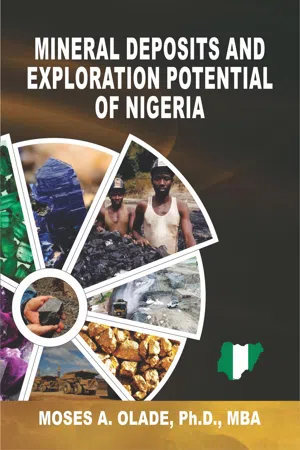
Mineral Deposits and Exploration Potential of Nigeria
Moses A OLADE
- English
- ePUB (apto para móviles)
- Disponible en iOS y Android
Mineral Deposits and Exploration Potential of Nigeria
Moses A OLADE
Información del libro
Nigeria, the most populous nation and largest economy in Africa is endowed with abundant mineral resources, including energy fuels, industrial minerals, gemstones, and metallic minerals. As West Africa has become a major destination for mining investors and exploration companies, Nigeria's mineral resources have generated considerable interest from exploration and mining companies worldwide. This book furnishes a detailed description of the deposits of metallic, non-metallic, solid energy, gemstones and industrial minerals in Nigeria with emphasis on their location, geological setting, mode of occurrence, physical and chemical characteristics, ore reserve estimates and metallogeny. It also provides a geoscientific analysis of the solid mineral sector, mineral production statistics, mining, and potential targets for mineral exploration.
There are twenty chapters in the book, divided into five parts. Part I is an introduction to mineral resources and discussion of the geological and tectonic setting and classification of Nigeria's mineral deposits. Part 2 provides detailed descriptions of known deposits of eighteen metals (Fe, Au, Pb, Zn, Cu, Ag, Sn, Nb, Ta, Mo, W, Ti, Bi, Cr, Ni, Pt, Mn, Al) with emphasis on their geological environment, mode of occurrence, mineralogy, origin, ore reserves mining history, and exploration. Part 3 describes the distribution, geological setting, and reserves of solid energy minerals (uranium, coal, and bitumen), while Part 4 focuses on the geological occurrence, mineralogical and physical properties, mineral reserves and uses of non-metallic minerals comprised of thirty industrial minerals/rocks and several gemstone minerals. Part 5 reviews the status of the solid minerals industry, new mining regulations, mineral production statistics, mining practices, metallogenic provinces, and assessment of resource potential and exploration targets in Nigeria. A Glossary of Common Terms in Economic and Mining Geology is included at the end of the book.
This book is an invaluable source of information, not only for geology and mining students, but also for practicing geoscientists, exploration and mining professionals and administrators in government and private companies who are interested or involved in economic geology, mineral exploration, and mineral resource development in Nigeria.
Preguntas frecuentes
Información
Mineral Deposits and Geological Setting
Chapter 1
Introduction to Mineral Deposits
Definition of Terms
Types of Mineral Resources
Nature of Mineral Deposits
Metallic Minerals | Non-Metallic Minerals | Energy Minerals |
Gold | Diamond | Coal |
Platinum | Barite | Lignite |
Silver | Kaolin | Oil Shale |
Iron | Limestone | Bitumen |
Copper | Phosphate | Uranium |
Lead | Zirconium | |
Zinc | Muscovite | |
Chromium | Feldspar | |
Manganese | Fluorspar | |
Tin | Gemstones | |
Cobalt | Gypsum | |
Tungsten | Bentonite | |
Aluminum | Rock Salt | |
Nickel | Talc | |